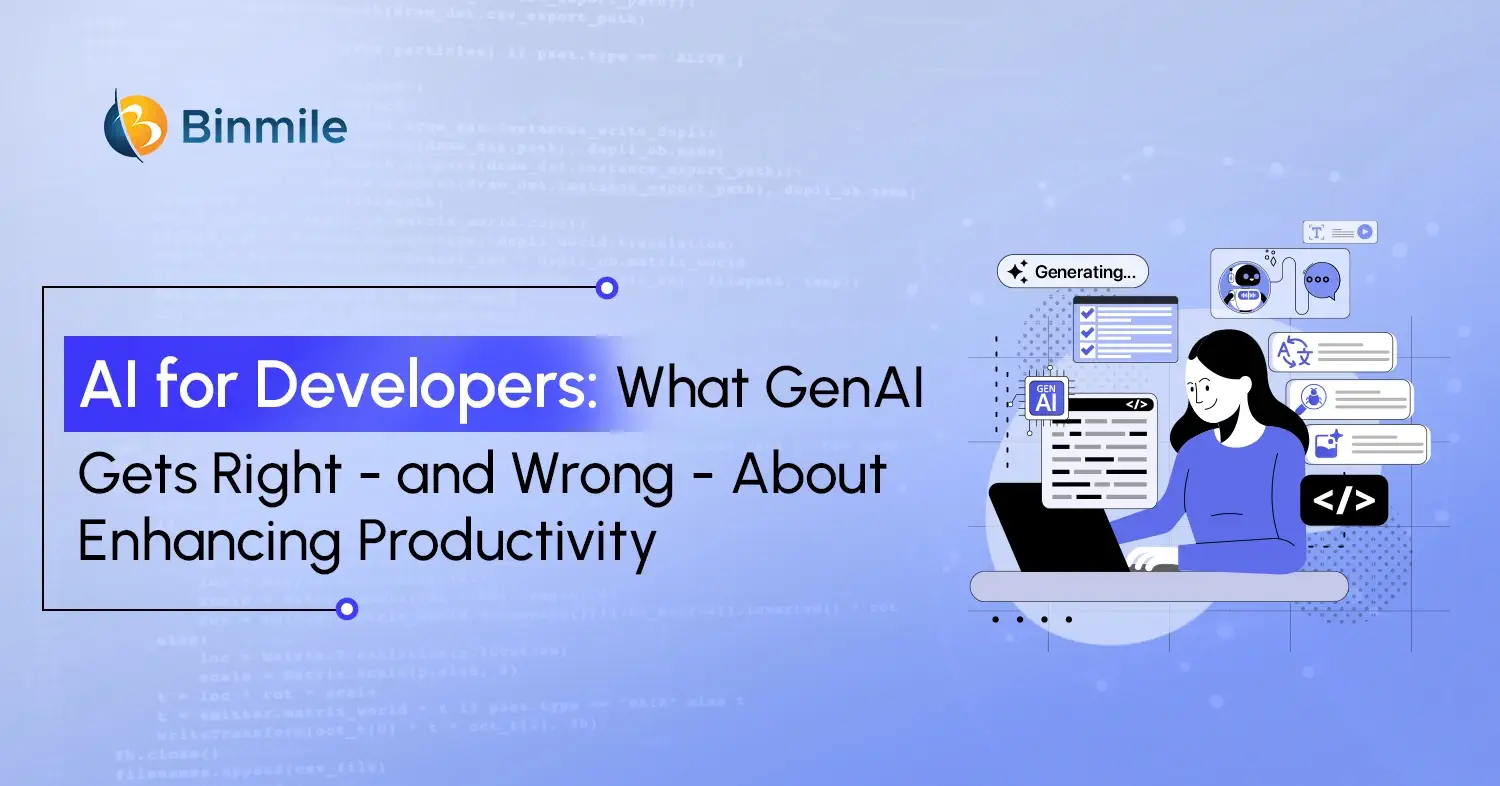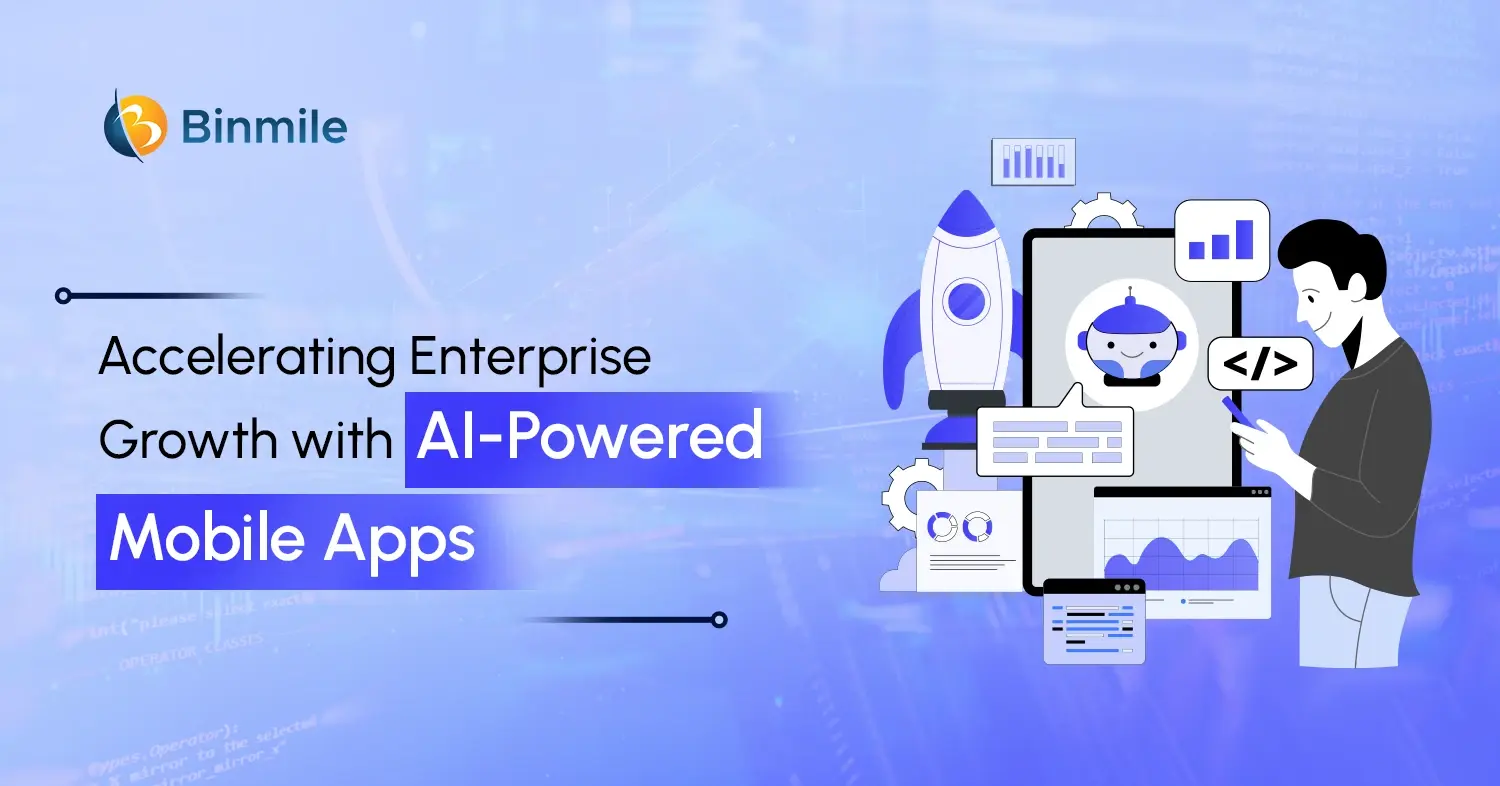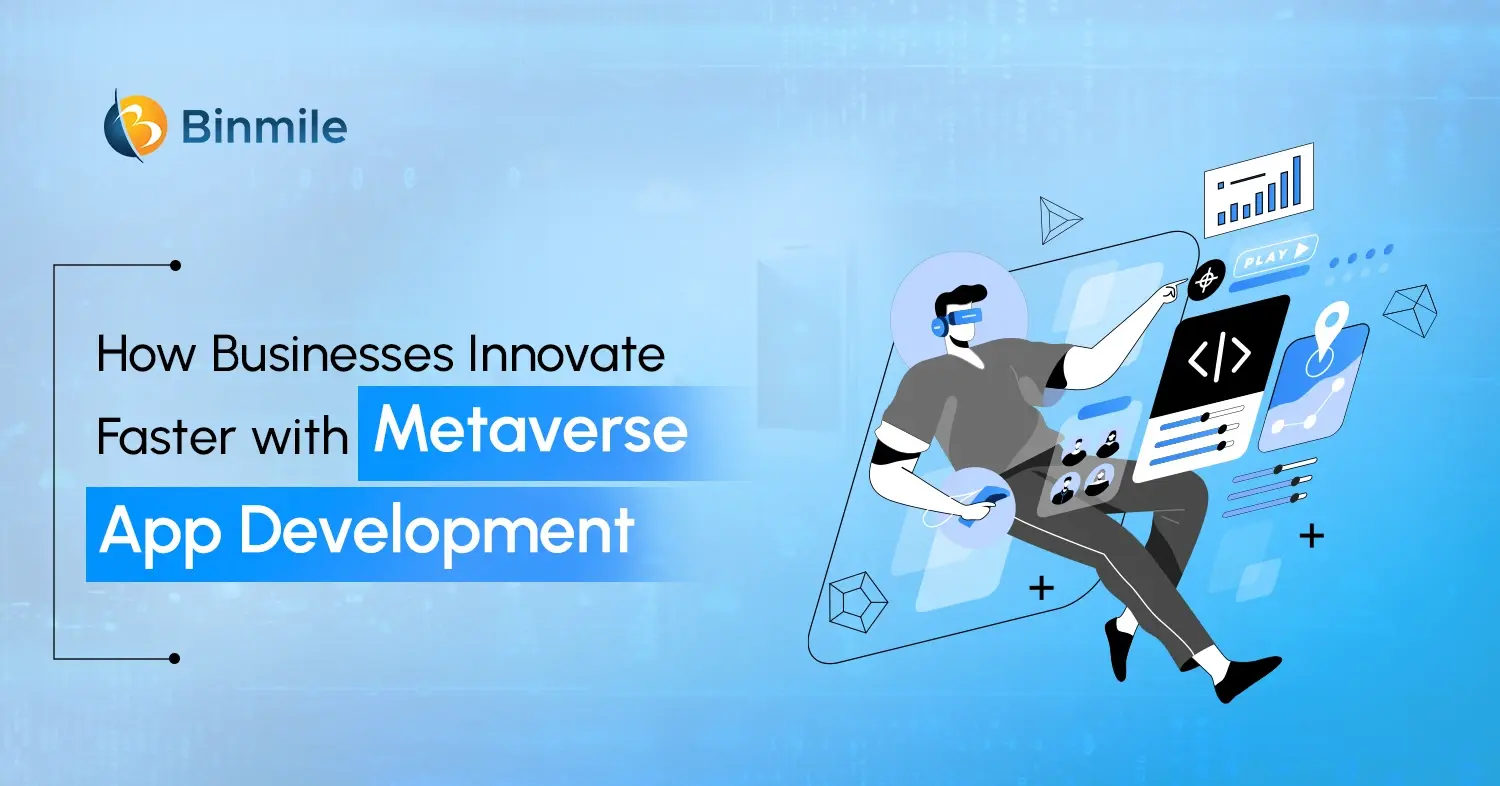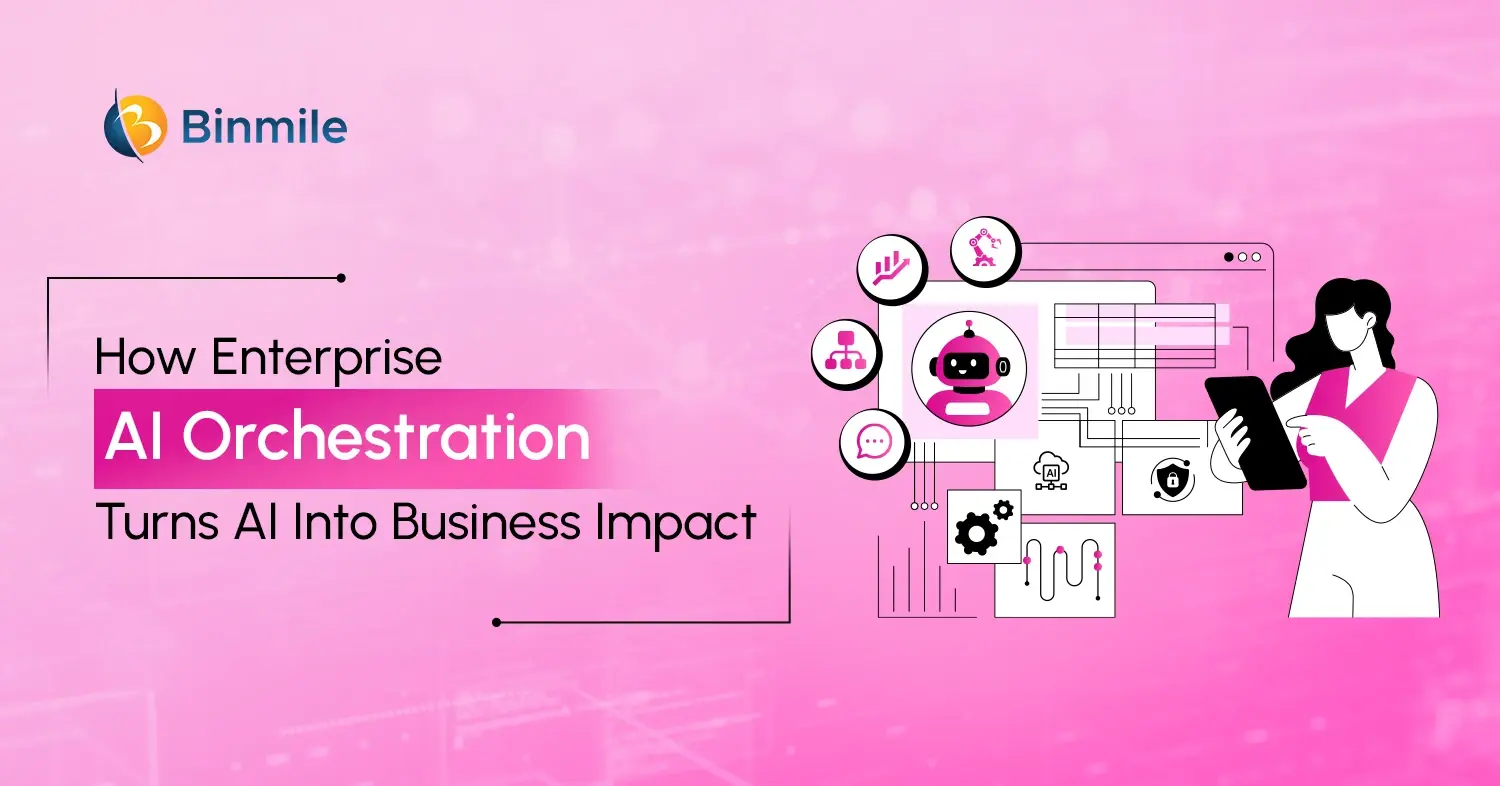With the advent of AI, especially generative AI, software development is changing rapidly. From autocompleting functions to generating the entire codebase, genAI has quickly become part of the developer toolkit. It’s a fact that generative AI is making software development simpler, shipping better, and delivering better.
But there’s more to it than just efficiency.
AI is bringing efficiency, creativity, and automation, but what happens to the time that’s freed up? Are developers actually doing more meaningful work, or just more? Is productivity actually going up, or are we measuring the wrong things? In this blog, we’ll explore the way GenAI tools are reshaping developer workflows. Additionally, we’ll also look at the latest DORA report and understand what insights it reveals regarding the impact of GenAI on developers’ speed, satisfaction, autonomy, and the future of developer productivity.
How AI is Enhancing Developers’ Productivity: 7 GenAI Use Cases
Generative AI, a type of artificial intelligence adept at creating new content, is rapidly transforming the development landscape. Here’s a closer look at 7 ways generative AI in software development can supercharge your development workflow:
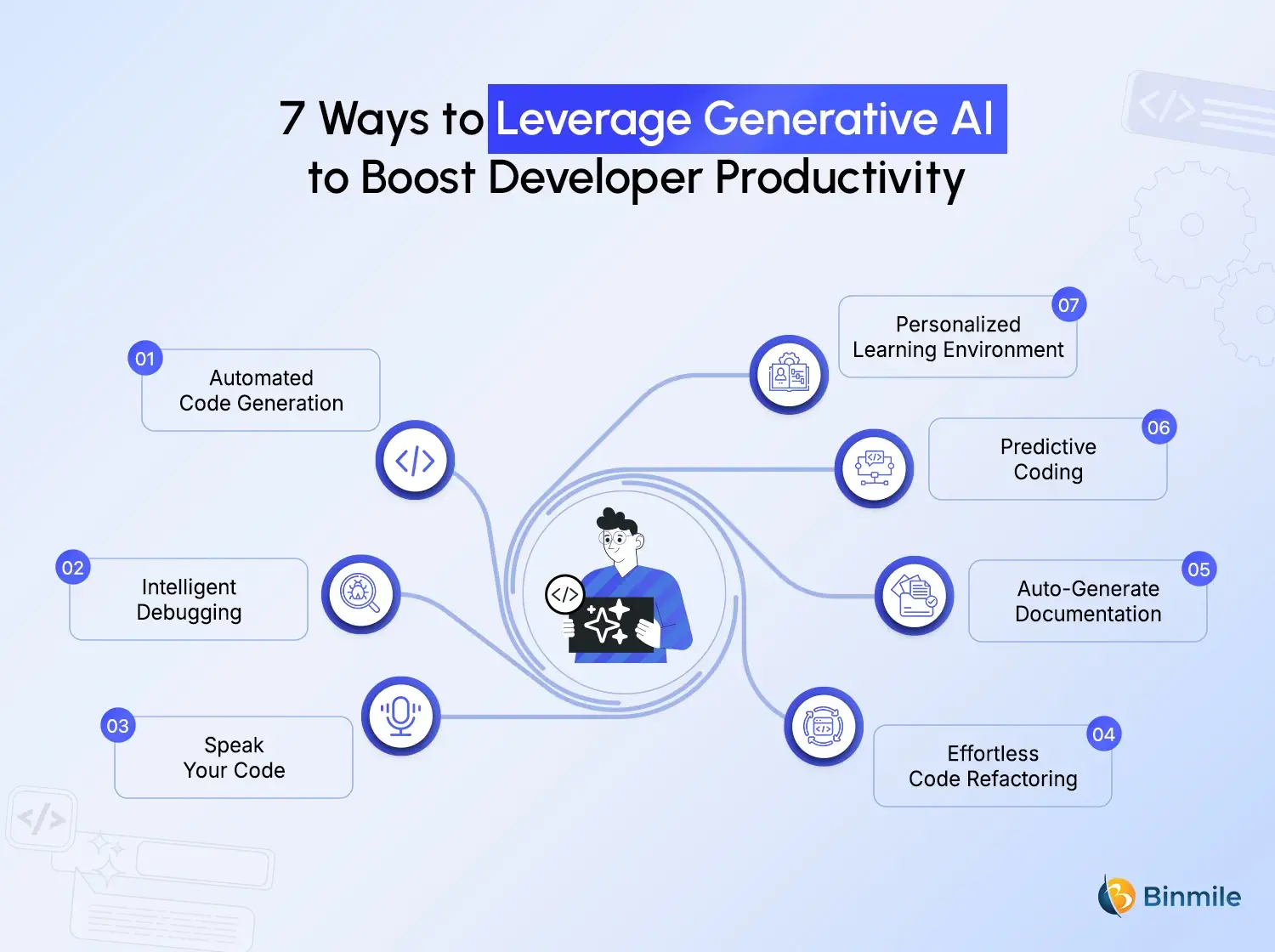
1. Automated Code Generation
Imagine a scenario where, while working on a project, you are not fully proficient in the language of that project. With generative AI, you can get the programming language you want your code snippet to be written in, but explain the purpose of that function in simple English. This helps you initiate new projects or continue the ones that you worked on earlier at a higher rate. It also allows working with new languages, with the possibility to expand the number of languages during development.
2. Intelligent Debugging
In general, finding vulnerabilities in the source code takes a relatively long time to debug. Generative AI is useful for automated code analysis and helps to detect vulnerabilities, which may later affect the performance of your application.
On top of it, some AI-powered testing tools can offer suggestions that are beneficial in making debugging a more manageable task, thus leading to more successful deployments. This saves developers a lot of time, effort, and resources wasted on analyzing several lines of code at a time.
3. Speak Your Code
There are chances communication issues might occur in the workforce during SDLC especially while discussing technical concepts. This is where Gen AI technology acts as an agent to bridge this communication gap. Developers can control these assistants through natural language interfaces.
Utilizing them, they can define deliverables with stakeholders in plain language, share development tactics with the broader workforce, or even receive code explanations in plain English. This streamlines work from the point of development and helps avoid misunderstandings, ensuring everyone is on the same page throughout the software development cycle.
4. Effortless Code Refactoring
Most codebases become cluttered and inefficient due to quick fixes and evolving project requirements. However, utilizing generative AI can analyze your code, define problem areas, and propose ways to refactor. It can then suggest better solutions to enhance the code. This makes it more comprehensible and manageable, improving the performance of your system.
By helping developers manage and maintain a clean and efficient codebase, we reduce technical debt and ensure the long-term health of the project.
5. Auto-Generate Documentation
Documentation is as vital as coding for any given project in an organization, as it is always a source of reference when other developers carry out the next project or assignment. However, code documentation is often considered a mundane and time-consuming activity, especially when time is of the essence. Implementing AI can automatically provide API references, tutorials, and even user manuals from code organization, blocks with comments, and typical usage.
This eliminates the need for developers to engage in documentation, which is often repetitive and time-consuming, and can be employed to add new value, such as new features and functionalities.
6. Predictive Coding
Imagine a code that plays ahead of you and tries to guess what type of code you are going to develop. This is where Generative AI comes to the rescue: It can recognize the patterns in code repositories and application development workflows to anticipate your next coding step. It can advise what a coder may do next in a specific coding context and direct the developer to the relevant libraries or common coding patterns.
It accelerates the app development process by lowering the time spent searching for resources and making decisions. Additionally, it also reduces decision fatigue, allowing developers to focus on core activities and work more efficiently.
7. Personalized Learning Environment
Generative AI for Developers helps developers create personalized development paths that adapt to their learning preferences or coding styles. Thus, it enhances productivity and makes the coding experience more comfortable for programmers.
Moreover, it can suggest tutorials, articles, and online courses that will be best suited for your task, to help you upskill as soon as possible. This not only empowers them to enter their flow state faster but also lets them embrace the continuously evolving technological environment.
The Value Vacuum: What the 2024 DORA Report Reveals About AI & Developer Work
We have learned so far how AI for developers has improved the developer experience by removing constraints to promote satisfaction, collaboration, and flow. This ultimately enhances their efficiency and productivity.
But Here’s the Catch: The Productivity Paradox
In 2024, the DORA report (DevOps Research and Assessment) confirmed what many in tech already suspected: generative AI is no longer optional. With 89% of organizations actively integrating AI into applications and 76% of technologists using AI daily, this shift is redefining the entire software development lifecycle.
However, we’ll shift focus to some of the interesting aspects that have not been talked about enough while examining the impact of AI in product development.
The Organizational Lens: Code Quality Up, Delivery Stability Down
The same 2024 DORA report reveals that while developers using GenAI report higher productivity, better job satisfaction, and more time in flow, they actually spend less time on work they consider valuable. Not more. Surprisingly, the time spent on repetitive, toilsome tasks? It doesn’t go down either.
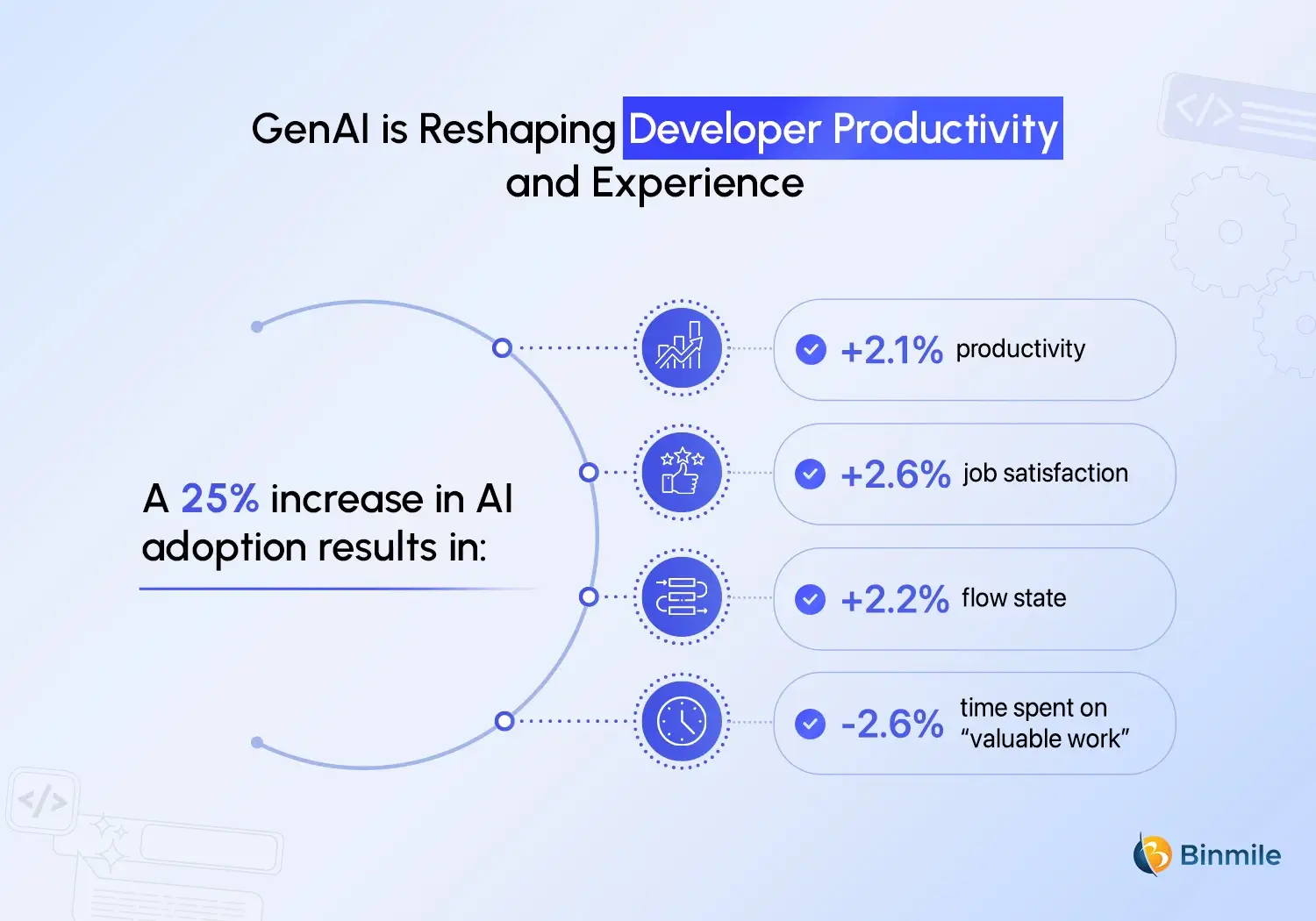
That’s the paradox. Developers are doing more, faster. But once the meaningful work is done, the remaining time doesn’t mean the developers are focusing on performing meaningful tasks. That creates what researchers of the DORA report called “value vacuum.”
The DORA team proposes the vacuum hypothesis: as AI speeds up valuable work, it creates time that is often filled with less satisfying, toilsome tasks, such as meetings and bureaucracy. This disconnect challenges a core promise of AI, which is freeing humans for more creative, high-impact work.
AI’s Upside for Teams
With 25% more AI adoption, organizations saw:
- +7.5% documentation quality
- +3.4% code quality
- +3.1% code review speed
- −1.8% code complexity
These improvements align with AI’s strengths: streamlining documentation, reducing boilerplate code, and accelerating development cycles.
But Here’s the Catch: Software Delivery Performance Declines
- −1.5% delivery throughput
- −7.2% delivery stability
Why? AI-generated code tends to increase changelist sizes, violating one of DORA’s cardinal principles: work in small batches. Without reinforcing DevOps best practices, AI becomes a double-edged sword.
Moreover, it’s a common belief that GenAI can replace human developers. But that is not true. AI is here to augment the SDLC process, making it faster and better. But without intentional use, the extra space it creates can feel like a dead zone rather than a benefit.
So, how do we even define what’s ‘value’ in a developer’s work? The DORA report discusses that as well. Let’s break this down further.
Rethinking the “Value” of Development Work with GenAI
Without going deeper into the philosophical angle, a developer’s work is more than just the output that is considered “valuable.” According to DORA’s research, a developer can assign value to their work in five different ways:
- Utilitarian: “My work has an impact.”
- Reputational: “I want credit for what I build.”
- Economics: “My skills and time should be compensated fairly.”
- Intrinsic: “I like mastering hard things.”
- Hedonistic: “I genuinely enjoy writing good code.”
And this is how Generative AI is enhancing the workflow, but there’s another side to the story. It is helping developers ship faster and increase impact. That’s a win for enterprise, sure. But at the same time, if GenAI does half the heavy lifting, who gets the credit? If it makes solving challenging issues easier, are developers feeling like they’re learning? If it autocompletes something a developer loves doing herself… is that still satisfying?
According to the DORA researchers, “Developers who prioritized the reputational value of their work—emphasizing the benefits of being recognized for having completed work—perceived gen AI as a potential value-reducer.”
Of course, these are personal, often conflicting questions. But they’re not hypothetical. If you want GenAI to actually enhance your development experience, this is the lens to look through.
5 Proven Strategies to Scale Gen AI Across Your Organization
So, how do we go about implementing generative AI in development without compromising on quality, ethics, and demoralizing developers? Is there even a middle ground that helps enterprises navigate these challenges? 5 strategic approaches ensure your organization can fully utilize AI in software development:
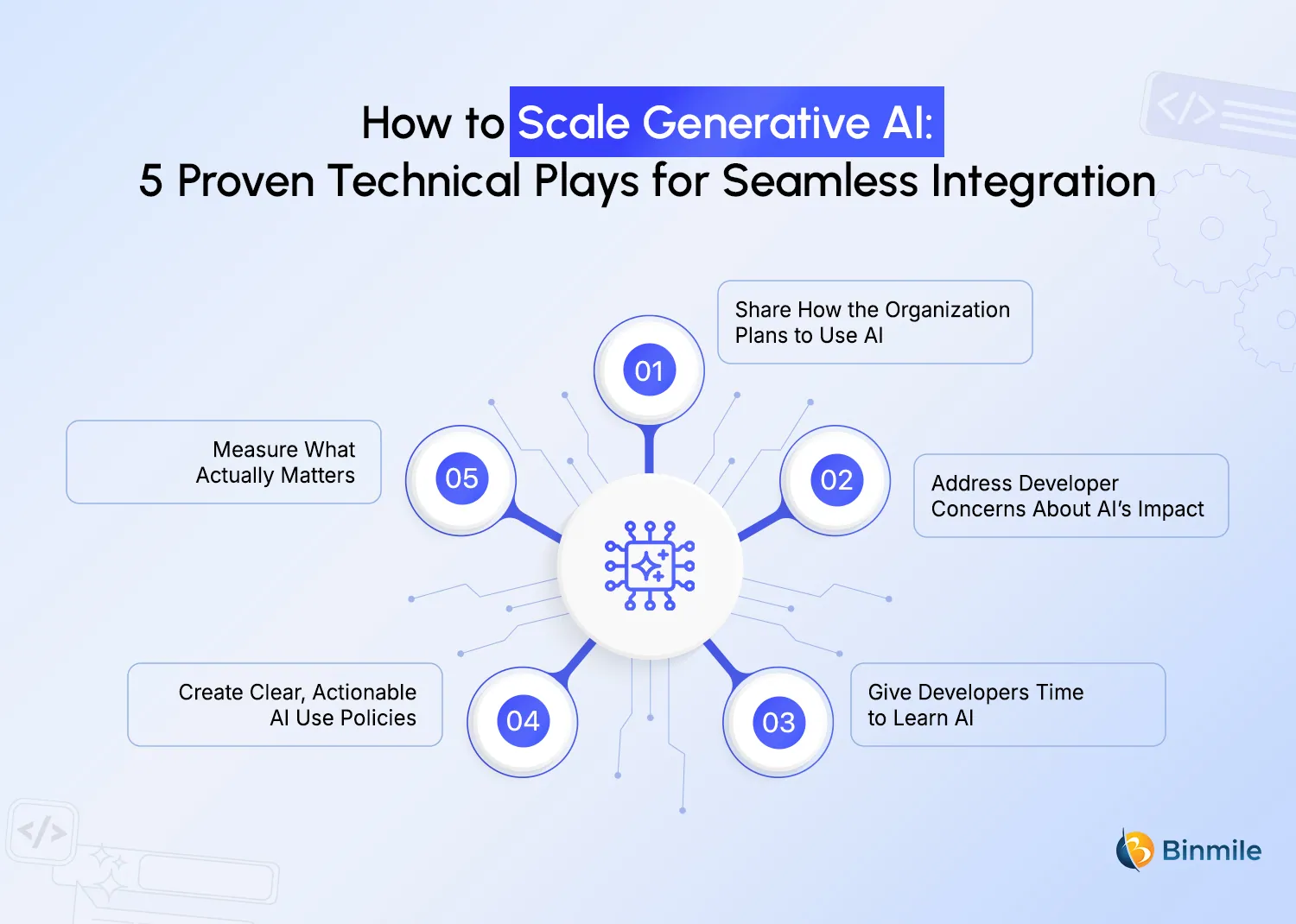
1. Share How the Organization Plans to Use AI
If your team doesn’t know why or how AI is being introduced, they won’t use it with confidence. Broad rollouts often fail primarily because the context around them is missing. Organizations that clearly communicated their AI plans saw an 11.4% increase in AI adoption across their teams. That’s just from being open about the intent and direction.
2. Address Developer Concerns About AI’s Impact
Not everyone sees AI as exciting, especially development teams. Since they worry that generative AI and its capabilities of automation will take away the parts of their job they care about, or worse, their job altogether.
Roughly 15% of developers believe AI could negatively affect their careers. But when organizations proactively addressed these fears, they saw a 125% increase in AI adoption.
3. Give Developers Time to Learn AI
Artificial intelligence as a technology is undoubtedly an exciting avenue for developers to explore. However, if you don’t give them the time and permission to explore AI tools without pressure, it won’t remain so anymore.
Therefore, create space in their workload to experiment, build prompts, test outputs, and understand where AI fits into their flow. Teams that offered dedicated time during work hours to explore AI saw a 131% increase in adoption. By comparison, mandatory AI training alone had less impact on meaningful engagement.
4. Create Clear, Actionable AI Use Policies
Vague guidelines about the ethical and secure use of AI don’t help, but clear policies do. That means, clearly communicating to your team where GenAI is appropriate, how to use it responsibly, and what boundaries exist around things like data, IP, and review processes.
Organizations that implemented specific AI use policies saw a massive 451% increase in adoption compared to those without any.
5. Measure What Actually Matters
Faster and streamlined development is your goal, but it shouldn’t be the only goal that you have before adopting GenAI. Moreover, productivity is no longer about how fast developers ship code. It’s also about how work feels, how teams collaborate, and whether the systems you’re building with AI are actually sustainable.
Therefore, track these metrics across three levels to get the complete picture:
Developer-Level:
- Flow state frequency
- Job satisfaction
- Burnout levels
- Perceived productivity
Team-Level:
- Code review time
- AI usage frequency
- Trust in AI outputs
Organization-Level:
- Delivery stability and throughput
- Documentation quality
- GenAI tool adoption (licenses, active use)
Wrapping It Up
It’s an indisputable fact that Generative AI has reshaped the way businesses offer applied AI services. Moreover, it’s been a game-changer in software development services, as harnessing it effectively has helped developers to not only build AI solutions more quickly and effectively but also boost their productivity. However, the real impact depends on how strategically it’s put to work. The 2024 DORA report is clear on one thing: AI alone doesn’t solve for productivity, quality, or team dynamics. It’s not a shortcut. It’s a tool that becomes an asset only if it’s backed by structure and with the right systems, goals, and accountability in place.
So, if you want to build workflows around how teams actually use GenAI, what changes should you track? To give developers the support they need to work with it, not around it, we recommend consulting an AI development company that can help. The AI experts can enable you to pursue generative AI’s promise of extraordinary productivity and unparalleled software innovation.
